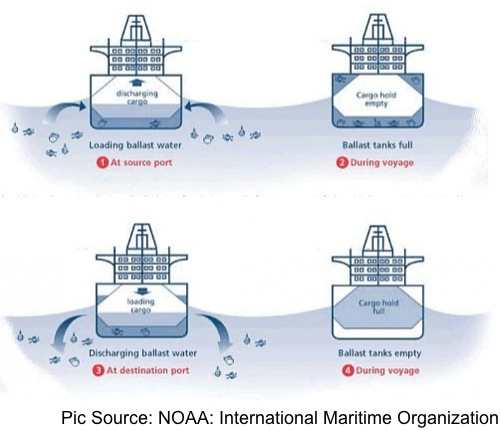Of Cholera and Kings: How Ballast Water Can Increase Shipping Costs (w/ video)
Where do cholera, international shipping, and the spread of invasive aquatic species all intersect? In the water that carriers use as ballast on voyages between international shipping destinations.
Ballast water is actually a huge “need for green” international shipping issue. As well as one that could have a serious impact on freight rates for ocean freight importers and exporters.
The International Maritime Organization (IMO) convened a conference back in 2004 to address the issue of environmental pollutants such as cholera and jelly fish caused by ships emptying their ballast at the end of a long shipping voyage.
 When ocean freighters jettison ballast water at the end of their voyages that they took on at a distant international port they often transfer non-native and sometimes very aggressive aquatic species into foreign waters. The destructive impact of this seemingly harmless practice has long been recognized by marine biologists and oceanographers. The question more recently has been how to solve the problem.
When ocean freighters jettison ballast water at the end of their voyages that they took on at a distant international port they often transfer non-native and sometimes very aggressive aquatic species into foreign waters. The destructive impact of this seemingly harmless practice has long been recognized by marine biologists and oceanographers. The question more recently has been how to solve the problem.
The international meeting of those involved in the shipping industry resulted in the drafting of a document called the Ballast Water Management (BWM) Convention to work to eliminate further environmental damage caused by ballast water.
This document set up guidelines for installing water purification systems on commercial carriers with a view toward eliminating the introduction of invasive species at international ports through the jettisoning of ballast water.[1]
Recently however the International Chamber of Shipping (ICS) wants to adjust the deadlines for the installation of these purification systems. Currently, the agreement was to install the purification systems within 2-3 years, but it is already 2012 and the Convention has yet to be enforced. The ICS is arguing that there will be a huge bottleneck if all cargo ships attempted the extensive retrofitting required to filter out invasive micro-organisms from their ships’ ballast within the next 2 years, when the BWM Convention is scheduled to finally be enforced by the IMO.
Also, the ship owners are challenging the requirement for older ships with limited time expected on the water before retirement. They want these ships which won’t be on the water too much longer to be exempt from installing the purification systems. They argue that the expensive (between $1 and $5 million USD) retrofitting is too much of an investment in ships which are over 18 years old and nearing the end of their life expectancy.
Much as classic cars are exempt from meeting low-smog emissions requirements in California, shipping companies are lobbying the IMO to make an exception for older vessels. They say the significant investment required to make older ships (which will likely only be on the water another 2-3 years) compliant would be economically crippling for them.
An alternate solution has been proposed for older ships. Instead of installing expensive purification systems, aged vessels could be required to jettison their ballast far out at sea instead of in port, thus reducing the negative environmental impact at busy international ports and those who live near them of ballast water elimination.
Having considered the proposal for an extension, I have a few reactions. First, while it seems reasonable to allow sufficient time for the retrofitting, 7 years have already passed since the BMW Convention was agreed upon. It seem like companies are dragging their feet to install the filtration systems. You may ask, what’s the big deal?
Having read about the damage invasive species had done years ago when scientists were first realizing the impact of emptying ships’ ballast in foreign ports, I was shocked by what more recent research has revealed are even greater dangers than first realized. While the negative impact on native fish and broader damage to ecosystems was familiar to me, I learned about the deadly impact ballast water can have on human populations.
I knew cholera was a water-borne disease, but I did not know that it could survive in ballast seawater for long trans-oceanic voyages. Strains of this deadly disease have been introduced to South America and the Gulf of Mexico due to ocean freight ballast.
Aside from water-borne diseases, other microscopic organisms such as toxic algae have bloomed in the Black Sea and set up a chain reaction of devastation at the very foundation of the food chain. In addition, shellfish grown amidst these toxic algal blooms can poison people who consume them. [2]
Considering that invasive species have already destroyed whole eco systems, including the Great Lakes, it seems worth it to enforce the convention and expect compliance within 3 years. The environment can’t afford further delays.
The problem seems to be carriers’ ability to afford these needed green changes in shipping practices. Meeting these green shipping requirements is one more cost carriers that are already struggling to be profitable need to undertake. The implementation of these changes is one more thing that would increase international shipping rates for ocean freight.
![]()
Source: Green
